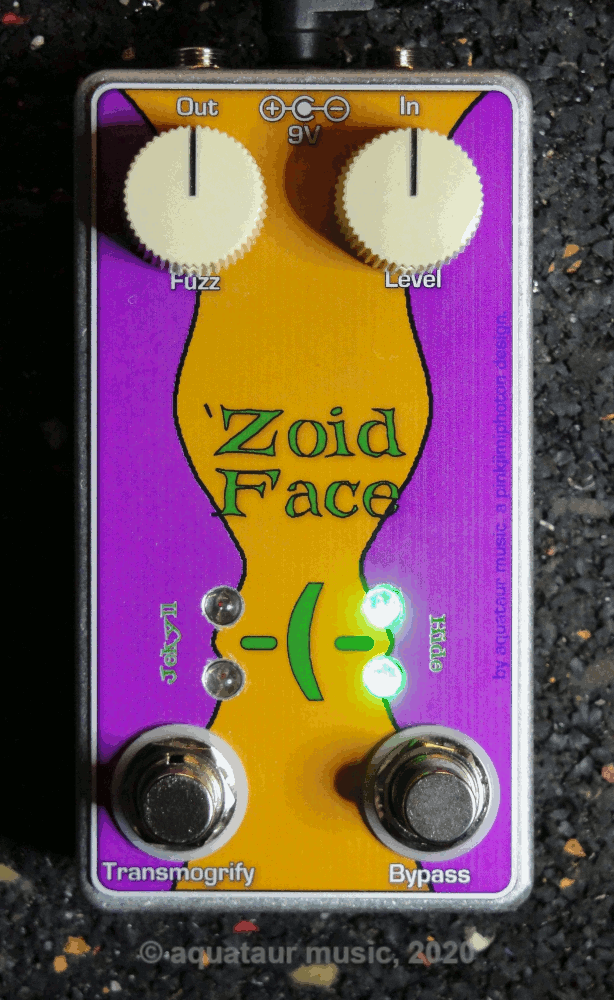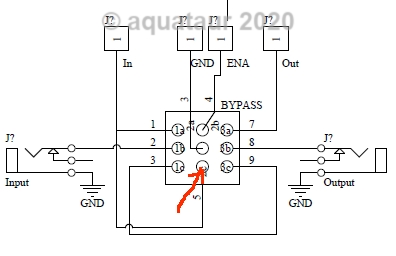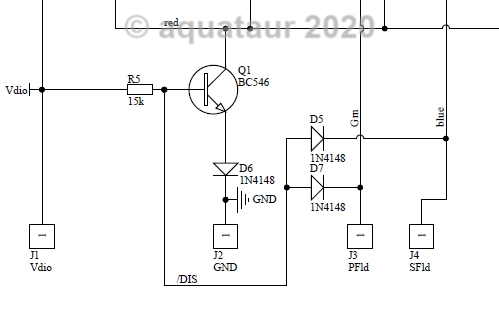|
The
´Zoid Face a.k.a. Schizoid
Face An extension of a pinkjimiphoton designed versatile silicon fuzz face last update: May 3, 2022 Copyright 2020-25 by
H. Gragger. All Rights Reserved. All information
provided herein is destined for educational and
D.I.Y. purposes only. Commercial re-sale,
distribution or usage of artwork without explicit
written permission of the author is strictly
prohibited. The original units with their
associated trade-names are subject to the
copyright of the individual copyright owner. The
Author is by no means affiliated with any of those
companies. References to trade names are made for
educational purposes only. By reading the
information provided here you agree to the Terms
of
Use. The working language
is kept in English as an aid. Read here
why.
|
||||||||||||||||||||||
| MAIN PAGE>MUSIC STUFF>ZOID
FACE Index
Abstract I was traversing the web and stumbled over Brother Photon´s works[1]. I was intrigued by the schizoid face, which is a fuzz face with two modes (a polished one and an evil one) and got in contact, since recently they blur the images on D.I.Y. forae. This has semi-improved meanwhile. After building some GE devices that come wrapped with some inevitable hiss, I set out to build this one. From past experience I know fuzzes are sensitive to driving impedance as shown in one of my earlier articles, it makes the guitar´s volume knob behave differently and makes the FF sound different. Not enough with that, the guitar signal is loaded down and loses clarity progressively. A buffer, which is normally called for rescue, is said to make the FF sound hard, but without, some other pedals will simply not interface with a stock FF. It is not true that the FF interacts with the volume control on the guitar, in a way that, say, a high capacity cable may form a resonance circuit together with the pickup when the volume is fully up.
So I like to buffer my faces. Fortunately, this is straight engineering applied. Even more fortunate, it is easy. It turns out that this FF unit, GE or not, sounds and behaves much like old GE units you can hear on the internet.
Back To Index Circuit Details
2022 changes here: I used a b-c cap of 22pF (Styroflex), 47pF appeared to big. The bias pot appears to settle at 3.5kOhm for greatest clarity. More insight[3] revealed that the above choice was working albeit being generic, but it was not what PJP was driving at (reply #9). I finally populated the circuit with exactly the values PJP designed for it (look at schematic V1.4). The obstinate collector won´t bias with the values given. I tweaked the trim pot until I achieved optimum symmetry on the oscilloscope. I concede that I am not sure if I tried hard enough to get the thing working with the emitter resistors. PJP recommends the following biasing procedure:
Input
Capacitors:
It might thus be a good idea to make the larger capacitor (Photon Fuzz side, what I call the evil and bodacious Mr. Hide side) slightly smaller (I used 2.2 µF) and leave the Stupid Fuzz side (what I call the anally retentive Dr. Jekyll side). I originally had an electrolytic capacitor in the first position, but it turned out that due to the buffer in front (and a signal with a DC offset on it) the right polarity could not be guaranteed, so I replaced this with a non polarized cap. The original PJP values for the caps serve exactly their destined purpose. The Stupid Fuzz's schematic bears similarity to the 1966 Vox Tone Bender (not to be confused with other Tone Benders). It has a very different quality than the Photon Fuzz. I believe that I have not exploited what can be done with the emitter resistors. PJP talks about the critical value that makes them sing... I do not know what to listen for. That said, it cleans up beautifully and sounds great. I have germanium units and I must say, I do not hear the difference the whole world rants about. Levels: when switching between the faces, some output level difference is noticeable. This may be useful or be remedied in the future, time will tell. Pots: PJP suggests a type A pot for the fuzz control (log), however most commercial units use a type C (antilog). I installed this and it spreads the usable adjustment range nicely apart. The output pot is type A. LED annunciation: it appears that upon switching a fairly loud pop is audible, which disappears if the LEDs are removed. This is a clear sign for LED inrush current creating a current surge that is picked up by the circuit. This is a common problem and is exaggerated by the fact that several LEDs are switched at the same time. I soldered 2µ2 capacitors (non polarized) across the control lines between red and blue resp. red and green. This efficiently slows down the current peaks to make switching pops bearable. TB MK-II switch: (later addon) By chance I found out that bridging the buffer´s drive resistance, catapults us into Tonebender Mk-II territory. This differs from a FF by an amplification stage preceding it. Looking at the schematic, this has a drive impedance of >10k. Since the buffer´s series resistance forms a voltage devider with the FF´s input impedance (only a few kOhms), bridging this yields a gain increase. Definitely into Mk-II territory. Great sound as demonstrated in the sound section. This eminently justifies the addition of an unobtrusive little switch on the side. Back To Index Verdict Due to the lack of a genuine GE FF I compared two devices with the ´Zoid face
All three FFs can´t deny their common
heritage and are obviously in the same ballpark, with
the Axis Face Silicon being a bit colored. The
´Zoid Face however is very flexible and sounds
totally uncolored. An extension of the guitar. I´ll
demonstrate that in the sound samples. It cleans up
reasonably well, maybe faster than the GE type and has
very many nuances of timbre you can adjust with the
guitar volume. The Brontoboost is different
since it is built on a different basis. So GE alone is
not all. It is the FF dirty goodness. First, if you are using any FF
type circuit, a bass cut facility on the
guitar is strongly recommended. This is not stock on
most guitars, but very helpful for overdriven sounds.
It helps to dramatically clean up distorted tones. Low
end gets in the way of the bass guitar anyway. Secondly, never run a FF into a clean
amp. It will sound brittle and awful. Try it.
Either you push your amp over the proverbial onset
of clipping through sheer volume, or put a mild,
tone-shaping overdrive of your choice after
the FF, which emulates exactly this. The overdrive, as
insignificant as this may be, does something
beneficial to tone. For the following sound samples I
use exactly that. You may want to read how to use your fuzz right. So bear in mind, any recording
you hear on the web, always reflects the whole sound
chain, which is where of course those guys are
cheating you. There is nothing constant and thus
comparable. Sound Samples
The recordings have been done using the following setup and no further processing:
A feq quick and nasty takes. No exercise in timing or else. Crank you speakers.
A few tests regarding buffered / unbuffered and an alleged similarity with Tonebenders MK2:(...)
SHAME. I fell for the age old trap.
I turned the Fuzz control down and lo and behold... apart from a little difference in loudness, both variants sound largely the same! Explanation: the 10k resistor with the 2k input impedance forms a voltage divider, kind of an input attenuator. The FF stage gets hit way harder. Another theory up the swanee. Back To Index [1] Pink Jimi Photon, Schizoid Face, youtube [2] Pink Jimi Photon, Schizoid Face, freestompboxes.org [3] DIYstompboxes (Pink Jimi Photon): presenting the Schizoid Face, https://www.diystompboxes.com/smfforum/index.php?topic=116989.0 Back To Index Update History
MAIN PAGE>MUSIC STUFF>ZOID FACE |
||||||||||||||||||||||
MAIN PAGE | MUSIC STUFF | IMPRESSUM  (c) 2020-25 AQUATAUR Musik & Elektronik |





